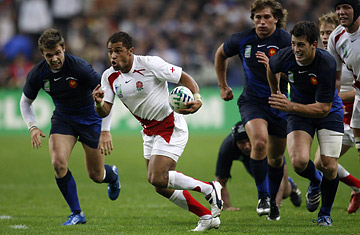
England's Jason Robinson, center, escapes from French players during their semi-final Rugby World Cup match at the Stade de France Stadium in Saint-Denis, near Paris.
For the 80,000, ferociously partisan fans who pack into Paris's Stade de France Saturday night, the only measure of victory will be whether England or South Africa walks away with the coveted Webb Ellis trophy. But the big winner of the 2007 Rugby World Cup has been the game itself. Never before has rugby drawn so wide a global audience as it has done over the past six weeks of the tournament, and never has it been seen to be played by people of such diverse cultural and socio-economic backgrounds. Forget the stereotypes: Rugby's getting popular.
Although it's unlikely ever to challenge soccer as the "world game," the interest and excitement the tournament has generated has marked the emergence of rugby's world cup as a major big-money sporting event. It drew an estimated 2.7 million spectators into stadiums, and a TV audience — accumulated over the entire tournament, including Saturday's final — of nearly 4 billion, an increase of nearly 25% over the 2003 event held in Australia. Although that forecasted total is dwarfed by the soccer World Cup, which drew a total TV audience of 30 million people, rugby's tally certainly rivals the Summer Olympics' for second place in global sports TV audiences.
Rugby has long enjoyed a sizable audience in Britain, Ireland, France, South Africa, Australia, and New Zealand and is developing a growing fan base in Argentina and Italy; the numbers of fans tuning in from such World Cup competitors as Tonga, Fiji, Georgia and the U.S. is tiny by comparison, however, so the 4 billion total means a lot more people from a growing number of nations around the world had to be interested enough to tune in.
That growing interest, and the skyrocketing revenues it generates, is rapidly making Planet Rugby a smaller place, as players are lured across borders and oceans to internationalize the sport as never before. As with soccer, England remains the prime destination of globe-trotting stars: The French team beaten by England in the semifinal included the mainstay of London pro club Wasps, Raphael Ibanez, as well as hirsute lock-forward Sébastien Chabal of Sale. And scores of players from Britain and Ireland play in the French league, where they'll soon welcome among them South African full-back Percy Montgomery, set to join Perpignan. Following the Cup, French fly-half Frédéric Michalak will make the reverse trip to take a job with South Africa's Natal Sharks; while the rapid rise of Argentina as a real contender has been due in large part the experience gained by 90% of its squad while playing pro rugby in either Ireland, England, or France. Their location poses a dilemma over in which annual tournament to include the Pumas — in the Tri-Nations tourney with fellow southern hemisphere teams South Africa, New Zealand, and Australia, or Europe's annual Six Nations tournament, which is, after all, closer to where the Argentine players now make their homes.
Nor is the growing World Cup audience the only indicator of rugby's spread: The big, TV-generated resources flowing into pro leagues and the regional international competitions continues fueling interest and participation as never before. In France, there has been an upsurge in youth and amateur squads way beyond French rugby's native, largely rural stronghold in the southwest, where its presence had long been a sign of English influence — France's new generation of top-level players is being drawn from youth squads in cities farther north. And, although less has been made of it than during France's victorious 1998 soccer World Cup campaign, the fact that the rugby team includes three African-born players and host of names resonant of Spanish, Italian and Polish origin demonstrates the game's role of integrating immigrants and their children.
The makeup of England's side is a reminder that there, too, rugby has spread far beyond its traditional domain as the erstwhile preserve of posh public-school types. Though a strong elite element remains, the current England team owes its success in part to such stars as Laurence Dallaglio, Paul Sackey and Jason Robinson (sons, respectively, of Italian, Jamaican and Ghanaian immigrants). Expect that diversity to grow: As television helps fuel rugby's popularity from the ground up, a rising number of the nation's best players will emerge from more modest milieus than Eton, Harrow and the school that gave the game its name, as kids from all social background embrace a game that "looks like fun."
Nowhere is the social makeup of the national rugby team more of an issue than in South Africa, where the sport which had been a totem of the white minority in the apartheid era still remains almost entirely composed of white players. That has sparked passionate debate over whether rugby's national squads should replicate the socio-ethnic demographics of the societies they represent. A laudable goal for all nations on earth, perhaps, but one that would make those four New Zealanders playing for Japan a little tough to explain.
